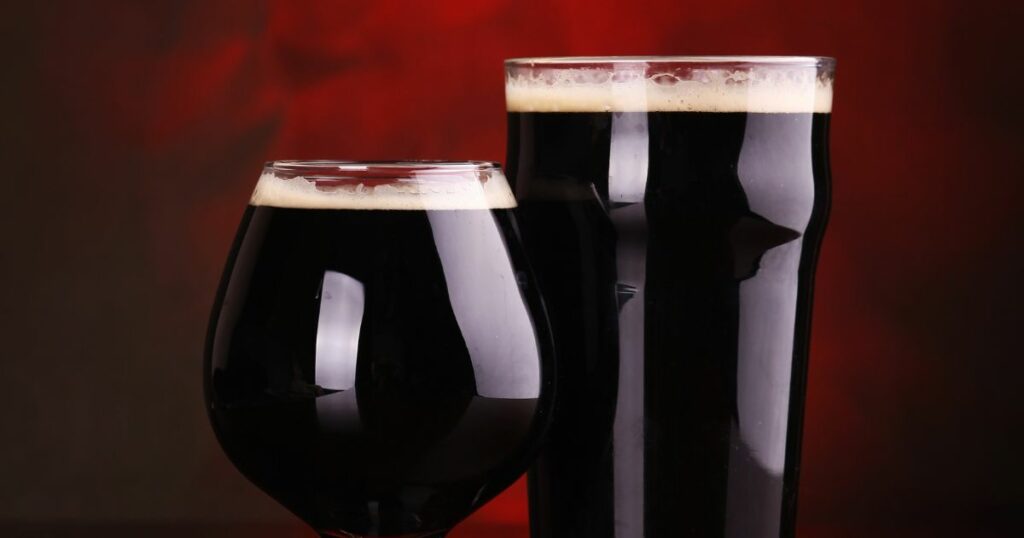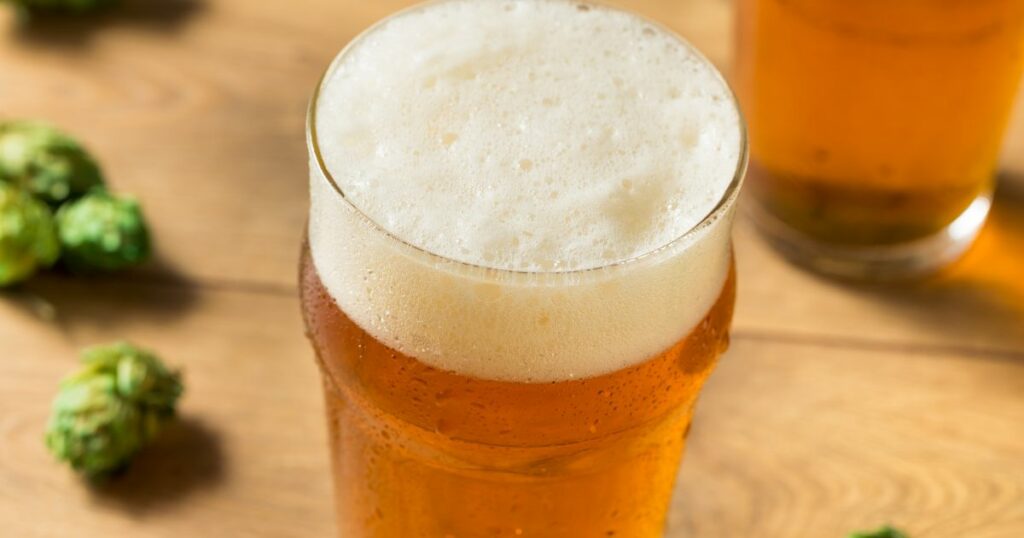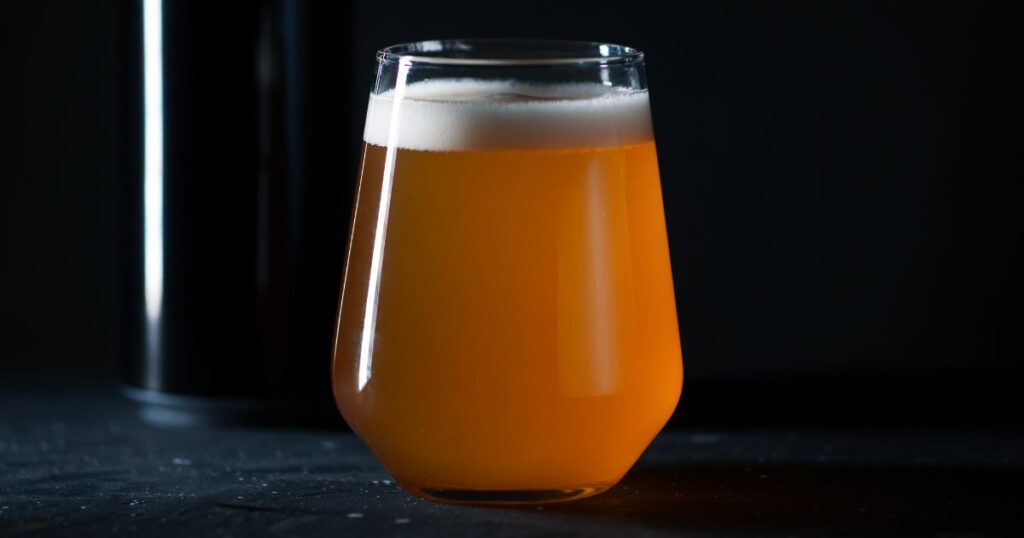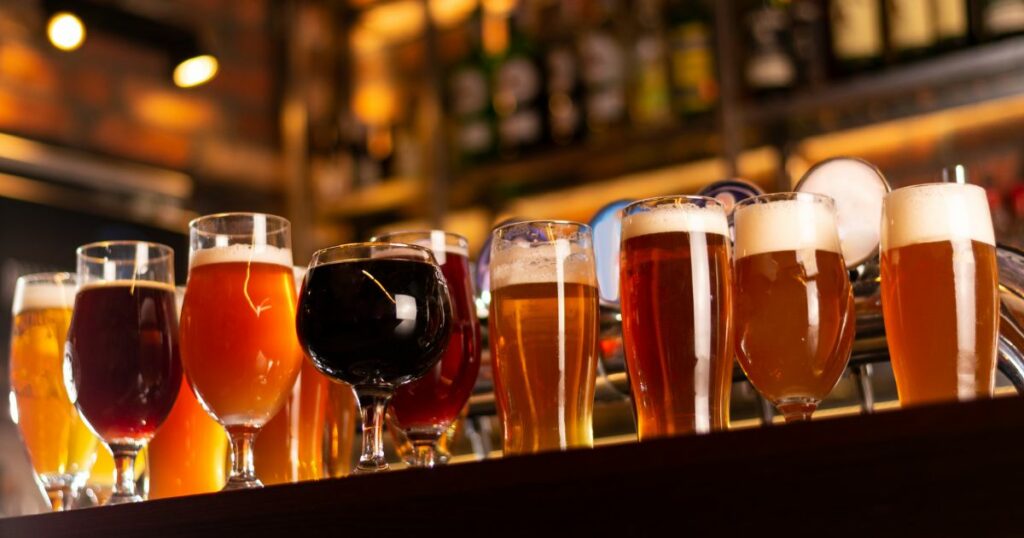The Alluring Ale

Ales are among the oldest beer styles, with origins dating back to ancient times. They are typically made using top-fermenting yeast, which ferments at warmer temperatures and results in a complex flavour profile. Ales come in various colours and flavours, ranging from light and fruity to dark and malty. The history of ale can be traced back to the Sumerians and Egyptians, who brewed their beer using barley and wild yeast.
Classic pairing: Pairings for ales vary widely, given the diverse range of flavours and styles. Lighter ales, such as pale ales and golden ales, pair well with light dishes like salads, chicken, and seafood, while darker, maltier ales, like brown ales and porters, are better suited to heartier fare like roast meats, stews, and aged cheeses.
The Lovely Lager

Lagers, unlike ales, are brewed using bottom-fermenting yeast, which ferments at colder temperatures. This process typically results in a cleaner, crisper flavour profile, making lagers very approachable and easy to drink. Lagers originated in Germany in the 15th century when brewers discovered that storing beer in cool caves or cellars resulted in a smoother, more refined product.
Classic pairing: Lagers are versatile when it comes to pairing with food. Lighter lagers, like pilsners and Helles, work well with spicy dishes, shellfish, and lighter cheeses, while darker lagers, like Munich Dunkels and Vienna Lagers, complement roasted or grilled meats, sausages, and heavier dishes.
The Sumptuous Stout

Stout is a dark, rich, and creamy beer style that originated in the British Isles. It is typically made with roasted barley, which imparts a strong, roasted flavour and dark colour. The most famous stout is undoubtedly Guinness, which was first brewed in Dublin, Ireland, in 1759. The stout has evolved over the years, with various styles emerging, such as dry stout, sweet stout, and imperial stout.
Classic pairing: Stouts are known for their robust flavours, which pair well with hearty, rich dishes. They complement savoury meat dishes, like steak, pot roast, or barbecue, as well as rich desserts, such as chocolate cake or brownies. The sweetness of a stout can also balance the heat of spicy dishes, making it a versatile pairing option.
The Wonderful Wheat Beer

Wheat beers are brewed with a high percentage of wheat malt, giving them a distinctive light, refreshing taste and a hazy appearance. Originating in Germany and Belgium, wheat beers come in various styles, such as Hefeweizen, Witbier, and Berliner Weisse. The use of wheat imparts a unique, slightly tart flavour that sets these beers apart from other styles.
Classic pairing: The light, crisp flavours of wheat beers make them excellent choices for pairing with lighter, fresh dishes. They work well with salads, seafood, and poultry, as well as tangy or citrusy dishes. Wheat beers also make a great accompaniment to soft, creamy cheeses and fruit-forward desserts, like fruit tarts or sorbets.
The Irresistible India Pale Ale (IPA)

India Pale Ales, or IPAs, have a storied history dating back to the 18th century. Originally brewed in England, these beers were designed to withstand long sea voyages to India, where British troops were stationed. They are characterised by their high hop content, which imparts a strong, bitter flavour and acts as a natural preservative. Over time, IPAs have evolved into a variety of substyles, such as English IPA, American IPA, and Double IPA.
Classic pairing: The bold, hoppy flavours of IPAs pair well with equally bold, flavourful dishes. Spicy foods, such as Indian and Thai cuisine, work well with the bitterness of an IPA, as do rich, fatty dishes like burgers or barbecue. The strong hop flavours can also balance the creaminess of blue cheese or the sweetness of caramelised onions.
The Spectacular Sour Beer

Sour beers are a diverse category of beers that are intentionally brewed to have a tart, sour flavour. This is achieved through the use of wild yeast strains and bacteria, which produce lactic and acetic acids during fermentation. Sour beers can be traced back to ancient brewing traditions in Europe, particularly Belgium, where styles like Lambic, Gueuze, and Flanders Red Ale were born.
Classic pairing: When it comes to pairing sour beers with food, the acidity and tartness of the beer play a significant role. Sour beers work exceptionally well with rich, fatty dishes, as the acidity helps to cut through the richness and cleanse the palate. They also pair nicely with tangy or pickled foods, such as sauerkraut or pickled vegetables, and can even be used to enhance fruit-based desserts.
The Brilliant Barleywine

Barleywines are strong ales with a high alcohol content, typically ranging from 8 to 12% ABV. Originating in England, they are made with a large quantity of malt, giving them a rich, sweet, and complex character. Barleywines can be aged like fine wines, often developing unique flavors and nuances over time.
Classic pairing: Pair barleywines with rich, hearty dishes, such as roasted meats, game, and strong cheeses. Their sweetness also complements rich desserts like bread pudding, crème brûlée, or cheesecake.
The Invigorating Irish Red Ale

Irish Red Ales are characterized by their reddish hue, moderate strength, and a balance of maltiness and subtle hop bitterness. Originating in Ireland, these ales often feature a toasted, caramel-like malt character and a smooth, easy-drinking finish.
Classic pairing: Pair Irish Red Ales with roasted or grilled meats, such as lamb or beef, as well as hearty stews and shepherd’s pie. They also complement mild to medium cheeses and earthy, nutty dishes.
The Delightful Doppelbock

Doppelbocks are strong, dark German lagers with a rich, malty profile. Originally brewed by monks as a source of sustenance during times of fasting, they are sometimes referred to as “liquid bread.” Doppelbocks are full-bodied and feature flavors of dark fruit, caramel, and toasted malt.
Classic pairing: Doppelbocks pair well with rich, hearty dishes, such as roasted or braised meats, game, and sausages. They also complement aged cheeses and chocolate or caramel-based desserts.
The Refreshing Radler

Radlers, also known as shandies, are a blend of beer and fruit juice or soda, typically lemonade or grapefruit juice. Originating in Germany, radlers offer a light, refreshing, and low-alcohol option, perfect for warm weather or as an easy-drinking alternative to stronger beers.
Classic pairing: Pair radlers with light, fresh dishes like salads, sandwiches, and seafood. Their fruity, citrusy character also complements spicy or tangy flavors, making them a good match for Asian or Mexican cuisine.
The Gorgeous Gose

Gose is a unique German beer style characterized by its tart, slightly sour profile and subtle saltiness. Brewed with coriander and salt, this wheat-based beer offers a refreshing, crisp drinking experience with a hint of spice.
Classic pairing: Gose pairs well with fresh seafood, particularly shellfish, as well as tangy, pickled dishes, and light, citrusy salads. Its tartness and salinity can also complement rich, creamy cheeses.
The Striking Saison

Saisons are a Belgian beer style known for their complex, fruity, and spicy flavors. Originally brewed by farmers during the winter months for summer consumption, saisons often feature notes of pepper, clove, and citrus. Their high carbonation and dry finish make them very refreshing.
Classic pairing: Pair saisons with a wide range of dishes, from light salads and seafood to grilled meats and spicy foods. They also complement earthy, funky cheeses and tangy, fruit-based desserts.
The Tantalizing Tripel

Tripels are a Belgian strong ale style known for their high alcohol content (usually 8-10% ABV) and complex, fruity, and spicy flavors. Typically golden in color, tripels are brewed with Belgian yeast strains, which impart unique esters and phenols that contribute to their distinct character.
Classic pairing: Pair tripels with rich, creamy dishes like risotto, pasta with cream sauce, or lobster bisque. Their fruity, spicy profile also complements strong, aged cheeses, as well as sweet, fruity desserts like tarts, fruit compotes, or pastries.
The Captivating Kölsch

Kölsch is a delicate, pale German ale that is unique to the city of Cologne. With a light, crisp character and subtle fruity and floral notes, Kölsch is often compared to lagers due to its clean finish. It is fermented with ale yeast at cooler temperatures, resulting in a hybrid style that combines the best of both worlds.
Classic pairing: Pair Kölsch with light, fresh dishes like salads, seafood, and poultry. Its delicate flavor profile also complements mild cheeses, sushi, and simple, herbaceous dishes.
The Memorable Märzen

Märzen, also known as Oktoberfestbier, is a rich, malty German lager with a beautiful amber color. Originally brewed in March (März in German) and stored in cool caves during the summer months, Märzens were traditionally enjoyed during the Oktoberfest celebrations. This lager features a balanced profile of toasted malt and mild hop bitterness.
Classic pairing: Märzens pair well with a variety of dishes, including roasted or grilled meats, sausages, and pretzels. They also complement earthy, nutty flavors, making them a good match for dishes featuring mushrooms or aged cheeses.
The Fascinating Flemish Red Ale

Flemish Red Ales are a unique Belgian beer style characterized by their reddish-brown color and a complex, sweet, sour, and fruity flavor profile. These beers are aged in oak barrels, which contribute to their distinctive taste and aroma. They are often compared to red wine due to their acidity and tannic qualities.
Classic pairing: Flemish Red Ales pair well with rich, fatty dishes, as their acidity helps to cut through the richness. They also complement tangy, aged cheeses and fruity, chocolate, or caramel-based desserts.
The Enchanting English Bitter

English Bitters are a classic British ale style known for their balanced profile of malt and hops. They come in various strengths, from session-strength Ordinary Bitter to stronger Extra Special Bitter (ESB). With a focus on drinkability, English Bitters showcase the subtle interplay between malt sweetness and hop bitterness, often featuring earthy and floral hop notes.
Classic pairing: Pair English Bitters with traditional British pub fare, such as fish and chips, bangers and mash, or a Ploughman’s lunch. They also complement roasted or grilled meats, as well as mild to medium cheeses.
The Pleasant Pilsner

Pilsners are a popular lager style that originated in the Czech city of Pilsen in the 19th century. Known for their crisp, clean flavor and light golden color, Pilsners showcase noble hop varieties, which lend a floral, spicy character and a moderate bitterness. This style has inspired many regional variants, including the German Pils and the American Pilsner.
Classic pairing: Pair Pilsners with a wide range of dishes, from light salads and seafood to spicy foods and hearty meats. They also work well with mild, creamy cheeses and simple, herbaceous dishes.
The Remarkable Rauchbier

Rauchbiers, or smoked beers, are a unique German beer style that features a distinct smoky character. This flavor comes from the use of malt that has been dried over open flames, imparting a smoky aroma and taste. The most famous Rauchbiers come from the town of Bamberg, where the style has a long and storied history.
Classic pairing: Pair Rauchbiers with smoked meats, sausages, and barbecue, as their smoky flavor complements these dishes perfectly. They also work well with strong, aged cheeses, as well as hearty stews and chili.
Conclusion
Beer is a fascinating world of flavours, textures, and history. With such a diverse range of styles and origins, there’s a beer for every palate and occasion. The art of pairing beer with food is a journey of discovery, allowing you to experience new and exciting flavour combinations. So the next time you’re enjoying a pint, be sure to experiment with different pairings and take your taste buds on a delightful adventure.
𐡸 𐡸 𐡸 𐡸 𐫱 𐡷 𐡷 𐡷 𐡷
Frequently asked questions
The primary difference between ale and lager is the type of yeast used in fermentation. Ales use top-fermenting yeast, which ferments at warmer temperatures, while lagers use bottom-fermenting yeast, which ferments at colder temperatures.
Yes, there are gluten-free beer options available. These beers are typically made using alternative grains, such as sorghum, millet, or rice, instead of barley or wheat.
Beer should be stored in a cool, dark place, away from direct sunlight or temperature fluctuations. Ideally, beer should be stored at a temperature between 10-13°C (50-55°F).
Certain beer styles, such as barleywines, imperial stouts, or Belgian strong ales, can be aged for several years, developing new and complex flavours over time. However, most beers are best enjoyed fresh and should be consumed within their recommended shelf life.
To pour a beer correctly, tilt the glass at a 45-degree angle and slowly pour the beer down the side of the glass. As the glass fills, gradually straighten it until it is upright, allowing a head of foam to form. This will release the beer’s aromas and improve the overall drinking experience.



